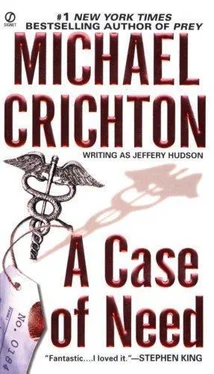Michael Crichton - A Case of Need
Здесь есть возможность читать онлайн «Michael Crichton - A Case of Need» весь текст электронной книги совершенно бесплатно (целиком полную версию без сокращений). В некоторых случаях можно слушать аудио, скачать через торрент в формате fb2 и присутствует краткое содержание. Город: New York, Год выпуска: 2003, ISBN: 2003, Издательство: Signet, Жанр: thriller_medical, на английском языке. Описание произведения, (предисловие) а так же отзывы посетителей доступны на портале библиотеки ЛибКат.
- Название:A Case of Need
- Автор:
- Издательство:Signet
- Жанр:
- Год:2003
- Город:New York
- ISBN:9780451210630
- Рейтинг книги:5 / 5. Голосов: 1
-
Избранное:Добавить в избранное
- Отзывы:
-
Ваша оценка:
- 100
- 1
- 2
- 3
- 4
- 5
A Case of Need: краткое содержание, описание и аннотация
Предлагаем к чтению аннотацию, описание, краткое содержание или предисловие (зависит от того, что написал сам автор книги «A Case of Need»). Если вы не нашли необходимую информацию о книге — напишите в комментариях, мы постараемся отыскать её.
A Case of Need — читать онлайн бесплатно полную книгу (весь текст) целиком
Ниже представлен текст книги, разбитый по страницам. Система сохранения места последней прочитанной страницы, позволяет с удобством читать онлайн бесплатно книгу «A Case of Need», без необходимости каждый раз заново искать на чём Вы остановились. Поставьте закладку, и сможете в любой момент перейти на страницу, на которой закончили чтение.
Интервал:
Закладка:
“Well,” Hendricks said. “We might as well get started.”
He went to the sink and began a long and thorough scrub. Pathologists who scrub for a post always annoy me. It makes them too much like parodies of surgeons: the idiotic reverse of the coin, a man dressed in a surgical uniform—baggy pants, V-neck short-sleeve blouse—cleaning his hands before operating on a patient who was past caring whether he received sterile treatment or not.
But in Hendricks’ case, I knew he was just stalling.
AUTOPSIES ARE NEVER VERY PRETTY. They are particularly depressing when the deceased is as young and as attractive as Karen Randall was. She lay nude on her back, her blonde hair streaming down in the water. Her clear blue eyes stared up at the ceiling. While Hendricks finished scrubbing, I looked at the body and touched the skin. It was cold and smooth, the color gray-white. Just what you’d expect for a girl who had bled to death.
Hendricks checked to see that there was film in the camera, then waved me aside while he took three pictures from different angles.
I said, “Have you got her chart?”
“No. The old man has that. All I’ve got is a summary of the OPD discharge.”
“Which was?”
“Clinical diagnosis of death secondary to vaginal hemorrhage complicated by systemic anaphylaxis.”
“Systemic anaphylaxis? Why?”
“Beats me,” Hendricks said. “Something happened in the OPD, but I couldn’t find out.”
“That’s interesting,” I said.
Hendricks finished with his pictures and went to the blackboard. Most labs have a blackboard, on which the pathologist can write his findings as he makes them—surface markings of the body, weight and appearance of organs, that sort of thing. He went to the board and wrote, “Randall, K.” and the case number.
At that moment, another man entered the room. I recognized the bald, stooping figure of Leland Weston. He was in his sixties, about to retire, and despite his stoop he had a kind of energy and vigorousness. He shook hands with me briskly, then with Hendricks, who seemed very relieved to see him.
Weston took over the autopsy himself. He began, as I remembered he always did, by walking around the body a half-dozen times, staring at it intently, and muttering to himself. Finally he stopped and glanced at me.
“Observed her, John?”
“Yes.”
“What do you make of it?”
“Recent weight gain,” I said. “There are striation marks on her hips and breasts. She is also overweight.”
“Good,” Weston said. “Anything else?”
“Yes,” I said. “She has an interesting hair distribution. She has blond hair, but there is a thin line of dark hair on her upper lip, and some more on her forearms. It looks sparse and fine to me, new looking.”
“Good,” Weston said, nodding. He gave me a slight, crooked grin, the grin of my old teacher. For that matter, Weston had trained most of the pathologists in Boston at one time or another. “But,” he said, “you’ve missed the most important finding.”
He pointed to the pubic area, which was cleanly shaven. “That,” he said.
“But she’s had an abortion,” Hendricks said. “We all know that.”
“Nobody,” Weston said sternly, “knows anything until the post is completed. We can’t afford to prediagnose.” He smiled. “That is a recreation reserved for the clinicians.” He pulled on a pair of gloves and said, “This autopsy report is going to be the best and most accurate we can make. Because J. D. Randall will be going over it with a fine comb. Now then.” He examined the pubic area closely. “The differential of a shaved groin is difficult. It may imply an operation, but many patients do it for purely personal reasons. In this case, we might note that it was carefully done, with no nicks or small cuts at all. That is significant: there isn’t a nurse in the world who can do a pre-op shave on a fleshy region like this without making at least one small slip. Nurses are in a hurry and small cuts don’t matter. So…”
“She shaved herself,” Hendricks said.
“Probably,” Weston nodded. “Of course, that doesn’t rule in or out an operation. But it should be kept in mind.”
He proceeded with the autopsy, working smoothly and quickly. He measured the girl at five-four and weighed her at one-forty. Considering the fluid she had lost, that was pretty heavy. Weston wrote it on the blackboard and made his first cut.
The standard autopsy incision is a Y-shaped cut running down from each shoulder, meeting at the midline of the body at the bottom of the ribs, and then continuing as a single incision to the pubic bone. The skin and muscle is then peeled away in three flaps; the ribs are cut open, exposing the lungs and heart; the abdomen is widely incised. Then the carotid arteries are tied and cut, the colon is tied and cut, the trachea and pharynx are cut—and the entire viscera, heart, lungs, stomach, liver, spleen, kidneys, and intestine are removed in a single motion.
After that, the eviscerated body is sewn shut. The isolated organs can then be examined at leisure, and sections cut for microscopic examination. While the pathologist is doing this, the deaner cuts the scalp open, removes the skullcap, and takes out the brain if permission for brain removal has been obtained.
Then I realized: there was no deaner here. [15] Deaner is a traditional term for the man who takes care of the dissecting room. It is an ancient term, dating back to the days when anatomy dissections were done by horse gelders and butchers. The deaner keeps the rooms clean, cares for the corpses, and aids in the dissection.
I mentioned this to Weston.
“That’s right,” he said. “We’re doing this one by ourselves. Completely.”
I watched as Weston made his cut. His hands trembled slightly, but his touch was still remarkably swift and efficient. As he opened the abdomen, blood welled out.
“Quick,” he said. “Suction.”
Hendricks brought a bottle attached to a suction hose. The abdominal fluid—dark red-black, mostly blood—was removed and measured in the bottle. Altogether, nearly three liters were withdrawn.
“I wish we had the chart,” Weston said. “I’d like to know how many units they gave her in the EW.”
I nodded. The normal blood volume in an average person was only about five quarts. To have so much in the abdomen implied a perforation somewhere.
When the fluid was drained, Weston continued the dissection, removing the organs and placing them in a stainless-steel pan. He carried them to the sink and washed them, then examined them one by one, beginning at the top, with the thyroid.
“Peculiar,” he said, holding it in his hands. “It feels like fifteen grams or so.”
The normal thyroid weighed between twenty and thirty.
“But probably a normal variation,” Weston said. He cut it open and examined the cut surface. We could see nothing unusual.
Then he incised the trachea, opening it down to the bifurcation into the lungs, which were expanded and pale white, instead of their normal pink-purple.
“Anaphylaxis,” Weston said. “Systemic. Any idea what she was hypersensitive to?”
“No,” I said.
Hendricks was taking notes. Weston deftly followed the bronchi down into the lungs, then opened the pulmonary arteries and veins.
He moved on to the heart, which he opened by making two looping incisions into the right and left sides, exposing all four chambers. “Perfectly normal.” Then he opened the coronary arteries. They were normal too, patent with little atherosclerosis.
Everything else was normal until we got to the uterus. It was purplish with hemorrhagic blood, and not very large, about the size and shape of a light bulb, with the ovaries and fallopian tubes leading into it. As Weston turned it in his hands, we saw the slice through the endometrium and muscle. That explained the bleeding into the peritoneal cavity.
Читать дальшеИнтервал:
Закладка:
Похожие книги на «A Case of Need»
Представляем Вашему вниманию похожие книги на «A Case of Need» списком для выбора. Мы отобрали схожую по названию и смыслу литературу в надежде предоставить читателям больше вариантов отыскать новые, интересные, ещё непрочитанные произведения.
Обсуждение, отзывы о книге «A Case of Need» и просто собственные мнения читателей. Оставьте ваши комментарии, напишите, что Вы думаете о произведении, его смысле или главных героях. Укажите что конкретно понравилось, а что нет, и почему Вы так считаете.









